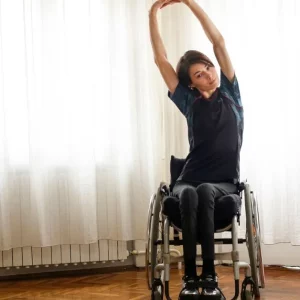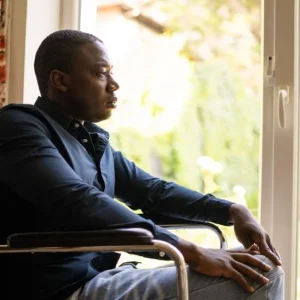Spinal cord injury paralysis, or loss of muscle function, occurs when the brain and spinal cord cannot communicate with the affected muscles in the body. Lack of communication between the brain and muscles can lead to paraplegia (paralysis in the lower extremities) or quadriplegia (paralysis in the upper and lower extremities).
The type of paralysis after spinal cord injury depends on the severity and level of injury. In order to receive proper treatment for spinal cord injury paralysis, an accurate diagnosis must be obtained. Timely management of paralysis is important in order to prevent further complications.
This article will discuss the causes of spinal cord injury paralysis, how to lower the risk of complications, and increase the chances of restoring movement in the muscles. Use the links below to jump straight to any section:
- Causes of spinal cord injury paralysis
- Is recovery possible?
- Complications of spinal cord injury paralysis
- Importance of passive exercise
- Recovery methods
Causes of Spinal Cord Injury Paralysis

The spinal cord is responsible for the transmission of messages between the brain and body. Communication is necessary in order to coordinate movement, control motor function, and respond to sensations. When messages get disrupted by damage from a spinal cord injury, it can result in weakness in the muscles or paralysis.
Paralysis can be temporary or permanent depending on the severity of your spinal cord injury. Spinal cord injuries can either be complete or incomplete. With a complete spinal cord injury, the spinal cord is fully severed and there are no spared neural pathways. As a result, movement and sensation below the level of injury do not exist.
With an incomplete spinal cord injury, the spinal cord is partially severed meaning there are intact neural pathways remaining. This increases the chances of restoring movement and sensation, as functions can be rewired through the neural pathways that remain.
The level of injury refers to the lowest region of the spinal cord where sensation and motor control exist. It determines the areas of your body where you may experience paralysis.
For example, individuals with a cervical spinal cord injury may experience quadriplegia (also known as tetraplegia), meaning they have paralysis in all four limbs. Survivors with a low-thoracic spinal cord injury may experience paraplegia, or paralysis in the lower limbs (legs).
Additionally, depending on the characteristics of the injury, muscles affected by paralysis may be either spastic or flaccid. These refer to increased or reduced muscle tone, respectively, and can occur in both the upper or lower extremities.
Is it Possible to Recover from Spinal Cord Injury Paralysis?
The chances of recovering muscle functions affected by paralysis mostly depend on your type of spinal cord injury. With a complete spinal cord injury, the spinal cord cannot heal or rewire itself because there are no intact neural pathways remaining. Therefore, the chances of recovery from spinal cord injury paralysis are much higher for an incomplete spinal cord injury since some neural pathways are left intact.
This is due to the process of neuroplasticity, or the central nervous system’s ability to adapt and rewire itself by sprouting new axons (connections) and reorganizing neural circuitry. With the help of neuroplasticity, existing neural pathways can be strengthened to improve function and new connections can be created.
Neuroplasticity in the spinal cord is best activated through high repetition of exercises, or massed practice. Practicing therapeutic exercises stimulates the central nervous system and helps it understand the demand for that specific task. The more repetitions you perform, the stronger the neural pathways for that skill become, maximizing your chances of recovery from paralysis.
Although the chances of recovering muscle function are much higher for incomplete spinal cord injuries, it’s also possible to regain functions if an incomplete injury is misdiagnosed as a complete injury because of spinal shock.
After an injury your spinal cord can enter a state of spinal shock where all reflexes and sensorimotor function below your level of injury are temporarily lost. This causes the muscles to feel limp which can lead many survivors to believe they have a complete spinal cord injury.
Spinal shock can last anywhere between a few weeks to several months. However, as swelling and inflammatory processes in the spinal cord go down, individuals with incomplete spinal cord injuries may notice certain functions and reflexes gradually improve.
However, it is important to note that recovery from paralysis may include more than just regaining muscle function. For those with complete spinal cord injuries, recovery can be pursued by maximizing your unaffected muscle function and using compensatory techniques to make up for abilities that are lost. For example, those with paraplegia may initially be unable to care for themselves, but can recover independence in their daily activities by using adaptive equipment, such as a leg lifter, hand controls for driving, and a shower chair.
Therefore, recovery should always be pursued regardless of the prognosis in order to maximize the chance of recovery.
Complications of Spinal Cord Injury Paralysis
Loss of muscle function can create many challenges for everyday life, but it can also lead to further complications if not managed properly. Common complications of spinal cord injury paralysis may include:
Pressure Sores
Developing pressure sores, or pressure ulcers, is a major risk of paralysis after spinal cord injury. Studies have shown that 23-30% of spinal cord injury survivors experience pressure sores, especially in bony areas such as the hips, knees, ankles, shoulders, elbows, and tailbone.
A lack of muscle function due to paralysis, often paired with sensation deficits, may result in individuals remaining in certain positions for long periods of time. This adds pressure to the skin, which can inhibit proper blood circulation, causing tissues to die.
If left untreated, this tissue breakdown can enter deeper areas in your body such as the bone, leading to infection and even death. Therefore, it’s especially important for survivors with spinal cord injury paralysis to reposition themselves often and constantly examine their skin for any signs of breakdown.
Osteoporosis and Muscle Atrophy
Individuals with spinal cord injury paralysis may also develop osteoporosis (weakened bone density) or muscle atrophy (shrinking muscles) due to lack of movement. Bones and muscles are strengthened by bearing weight and exerting energy through everyday movements. Without movement, the muscles can lose their function.
The body is extremely energy efficient. Though it takes more energy to move larger muscles, if you don’t use them they can shrink due to an imbalance between protein synthesis and protein degradation. Weak bones and muscles can increase the risk of serious injury by creating an unstable framework.
This instability can make you more susceptible to falling and fracturing your bones. Keep in mind the ‘use it or lose it’ concept to remember how important it is to continue moving your affected muscles after a spinal cord injury.
Bladder and Bowel Dysfunction
Another complication of spinal cord injury is the loss of bladder and bowel control. Paralysis is often accompanied by impaired sensation, which can make it difficult to sense when your bladder or bowel needs to be emptied.
If not managed properly, bladder and bowel dysfunction can result in frequent accidents. To prevent unwanted accidents, some management techniques include catheterization (or other forms of manual waste removal), prescribed medication, maintaining a consistent evacuation schedule, and possibly surgery. Consult with a doctor to find the appropriate treatment for you.
Spinal cord injury paralysis can increase the risk of further injury. To prevent paralysis from worsening or developing serious complications, survivors must engage in rehabilitation exercises to stimulate the nervous system and promote movement.
The Importance of Passive Exercise for Spinal Cord Injury Paralysis
Exercise is the most effective way to stimulate neuroplasticity after a spinal cord injury, promote blood flow, and encourage movement. However, with paralysis it can be challenging to perform active exercises.
Fortunately, passive exercises are just as effective and do not require you to move your body independently. Passive exercises are performed with the assistance of your unaffected limbs or with the help of a therapist or trained caregiver.
Passive exercise allows your affected muscles to be moved for you. Even if you have limited or no mobility due to paralysis, passive exercises help stimulate neuroplasticity and send signals to the nervous system.
Performing passive range of motion exercises can also help promote proper blood flow, maintain range of motion in the joints, and minimize the risk of complications. With time and consistent practice, you can increase your chances of recovery from spinal cord injury paralysis.
Recovery Methods for Spinal Cord Injury Paralysis
Various types of therapy, such as physical therapy and occupational therapy, help survivors achieve high repetition of exercises in their affected limbs. Whereas physical therapy exercises focus on improving functional mobility, occupational therapy exercises focus on improving performance with the activities of daily living.
Occupational therapists are especially helpful in introducing compensatory technique for those with complete spinal cord injuries, so that they can pursue recovery even if they are unable to regain muscle function.
Both PT and OT are essential to help improve paralysis after spinal cord injury. Unfortunately, therapy sessions are not always covered by insurance, leaving survivors to only practice 1-2 times a week. While this is helpful, 1-2 therapy sessions per week is not nearly enough to achieve massed practice.
To stay focused and engaged in between your outpatient sessions, it’s important to have a suitable home exercise program for spinal cord injury. Your therapist can create a rehabilitation plan that is suitable and safe for your ability level. They can also train a caregiver to safely help you practice exercises passively if you cannot do so on your own.
For an added boost of motivation, you can use home therapy devices such as MusicGlove and FitMi. MusicGlove focuses on improving hand function and FitMi focuses on improving full-body mobility. Both provide exercises that can be done passively or actively from the comfort of your own home.
Exercise is undoubtedly the best way to manage paralysis after spinal cord injury. However, depending on the severity, some survivors may benefit from other types of treatment as well. This can include a combination of:
- Prescribed medication
- Botox injections (for spastic paralysis)
- Exoskeletons
- Electrical stimulation
- Advanced nerve surgery
Some treatments are more invasive than others. Be sure to consult with your doctor first to obtain a proper diagnosis of your paralysis.
Understanding Spinal Cord Injury Paralysis
Spinal cord injury paralysis can be permanent or temporary depending on the severity and whether the injury was complete or incomplete. Finding effective management techniques for paralysis is important in order to prevent further injury and complications.
The best method for managing paralysis and encouraging neuroplasticity is through passive exercise. High repetition of passive exercises can stimulate the nervous system and promote movement and sensation.
We hope this article helped you understand how you can maximize your chances of recovery from spinal cord injury paralysis.











